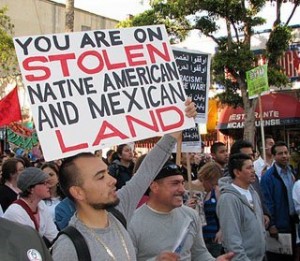May
14
If you listen to guys like Howard Zinn and others of the “anti-America” crowd, you’ll hear a lot of complaining about America’s “imperialist” ambitions and the way the American government and society have horribly treated various (usually) non-white groups, stolen their land, etc. The 19th-century notions of American expansionism and “Manifest Destiny” — i.e., that the United States (particularly white people) were meant (perhaps divinely so) to spread across North America — comes up a lot. Understand, I’m not dismissing it or saying that it was all good, either. In fact, anyone serious about history has to admit that certain people took that idea a little too far — unscrupulously so. There were indeed some nasty people who did some nasty things; bad policies and bad decisions were made; in some cases, lives were lost. But, I’m afraid that revisionists of recent decades have twisted things to make it sound a lot worse, attribute sinister motives where there often were none, and portray American settlers moving westward as greedy, racist land-grabbers and generally as bad eggs. That’s my sense of it, anyway.
 This year marks the 175th anniversary of the Texas Revolution, so you will probably hear/read some “progressive”-type journalists and historians making a lot of hoo-ha about it. The evils of the proponents of “Manifest Destiny” will be decried and some (e.g., National Council of La Raza) will continue their screeds of having their land stolen out from under them.
This year marks the 175th anniversary of the Texas Revolution, so you will probably hear/read some “progressive”-type journalists and historians making a lot of hoo-ha about it. The evils of the proponents of “Manifest Destiny” will be decried and some (e.g., National Council of La Raza) will continue their screeds of having their land stolen out from under them.
Well, I’ve got a few facts to help counter some of the claims and nullify the anti-expansionist rants about the origins of the Republic (and, later, State) of Texas:
1. Once Mexico gained its independence from Spain in 1821, it soon became one of the most poorly-governed countries in the world: corrupt, disorganized, tyrannical, faction-ridden, continually on the verge of civil war, arrogant and completely inept in its dealings with other nations. It didn’t help that the new nation was basically bankrupt and couldn’t defend its states/territories against hostile Indian tribes.
2. By 1836 most of the inhabitants of the Mexican state of Texas — known as “Texians” — were Anglo-American settlers, not Hispanics. This was due to liberal Mexican immigration law and empresarial grants for settlement. Yes, the Mexican government invited non-Mexicans in. (The General Colonization Law of 1824 made all heads of household who were citizens of, or immigrants to, Mexico eligible to claim land. However, in 1830 President Bustamante instituted a prohibition against further immigration to Texas from the U.S. Property tax exemptions were also rescinded and tariffs on U.S. goods were increased.)
3. Disillusionment and discontentment grew among Texas’ inhabitants. With the support of most of the native-born Hispanic inhabitants, the Texians then revolted against the corrupt, tyrannical, often brutal regime of General Antonio Lopez de Santa Anna.
4. Texas was not alone in revolting against the central government in Mexico City during the 1830s. So did California (repeatedly), Oaxaca, Jalisco, Zacatecas, Michoacan, San Luis Potosi, Queretaro, Durango, Guanajuato and Yucatan. Revolts broke out across the entire country (not just Texas), led by Hispanics and Anglos alike. Unfortunately, only the Texan revolt was successful.
5. The U.S. government provided no assistance to the revolutionaries in Texas, and — at least, initially — refused to annex the province once it achieved its independence from Mexico. The only assistance the Texians received was from individual volunteers (e.g., Davy Crockett and his Tennesseans).
6. Santa Anna was defeated by Sam Houston (who was heavily outnumbered) at the Battle of San Jacinto and signed the Treaties of Velasco, conceding Texas’ independence and recognizing the Rio Grande as the boundary between the new Republic of Texas and Mexico. Santa Anna also pledged to secure ratification of the treaty by the Mexican legislature, but he failed to keep this promise.
7. For the next ten years the government of Mexico refused to recognize the existence of the independent Republic of Texas, claiming that it remained Mexican territory. Mexico simultaneously made the contradictory claim that the southern border of Texas was at the Nueces River, rather than the Rio Grande. It failed to support or defend either of these claims, thereby conceding the de facto existence of the Republic of Texas with its southern border at the Rio Grande.
8. The fact that Mexico refused to ratify the treaty or that the border of the former Mexican state of Texas had been at the Nueces River could be argued to be rather beside the point. A nation’s independence is confirmed by its ability to defend that independence against attempts by another nation to extinguish it, which Texas did from 1836 to 1845. Put another way, the right to territory is not established by a treaty only, but by occupancy, and the ability to hold the territory claimed against attempts by others to seize it, as Texas did from 1836 to 1845.
Mexico made at least two attempts to reoccupy the land between the Rio Grande and the Nueces and was driven back across the Rio Grande on each occasion, thus confirming Texas’ de facto right to the area. For ten years Mexico failed to enforce its claims either to the territory between the Rio Grande and the Nueces rivers or to the whole of Texas.
So, similar to the American Revolution, the inhabitants of Texas rose up against an abusive government, declaring their independence and (against all odds) fighting to keep it. No “stolen” property. I think they earned it.
















